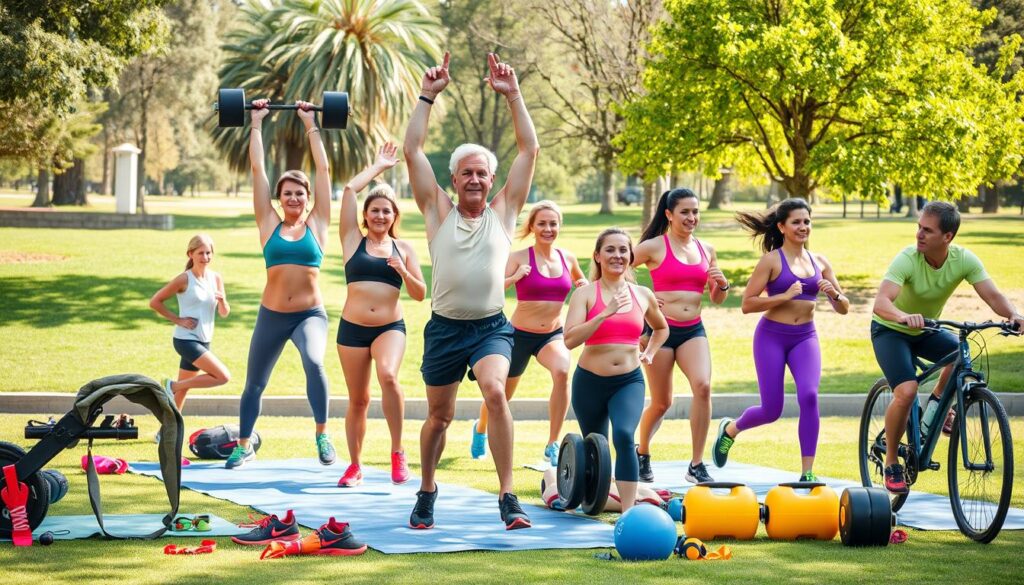Welcome to our easy-to-understand guide on fitness. This guide will help you live a healthier life and reach your fitness targets. Whether you’re a beginner or improving your fitness plan, getting advice that fits you is key. We’ll share tips and knowledge you need to make smart fitness choices.
From fitness basics to creating a plan just for you, we cover all you need to know. Everyone at any fitness level can find something useful here.
Table of Contents
ToggleKey Takeaways
- Understanding the importance of fitness is crucial for improving health.
- Setting realistic fitness goals is key for sustained motivation.
- Optimal health begins with balanced nutrition and proper workout routines.
- Personalized fitness plans enhance success rates for individuals.
- Adapting to changes in your body, especially with age, is vital.
- Incorporating fitness into daily life can be achieved through practical strategies.
Understanding Fitness Basics
Fitness plays a key role in our overall health. It affects both our bodies and minds. Learning the basics of fitness shows us how it helps balance our lives. Knowing about different fitness aspects helps us make smart health choices.
The Importance of Fitness
Regular exercise cuts down chronic disease risks. It helps you live longer and think clearer. Fitness is more than looking good. It builds strong bodies and minds. Staying active improves heart health and weight control. It also strengthens our immune system for a better life.
Key Components of Physical Fitness
Fitness is more than just exercising. It combines several key parts for a healthy life. These parts include:
- Cardiovascular Endurance: How well the heart and lungs supply oxygen during long activities.
- Muscular Strength: The most force a muscle group can exert.
- Flexibility: How far a joint can move.
- Body Composition: The body’s fat versus lean mass ratio.
Each component is crucial for a complete fitness routine. They improve our health and daily performance. By balancing these areas, we ensure better overall functionality.
Setting Realistic Fitness Goals
Setting good fitness goals is key to long-term success. When making goals, it’s smart to use the SMART criteria. This makes sure goals are clear, doable, and motivating.
SMART Goals Explained
SMART means Specific, Measurable, Achievable, Relevant, and Time-bound. Each part helps create a solid fitness goal:
- Specific: Say exactly what you want. Like, change “I want to get fit” to “I want to run 5 miles non-stop.”
- Measurable: Make your goals have numbers. You can track how far you run, how much you lift, or how long you exercise.
- Achievable: Your goal should be something you can actually do. Too hard goals can make you upset.
- Relevant: Your goals should fit your bigger fitness dreams and how you live your life.
- Time-bound: Give your goal a deadline. It helps you stay on track and be responsible.
Tracking Your Progress
Keeping an eye on how you’re doing is crucial. It keeps you going and lets you tweak goals if you need to. Use journals, fitness apps, or gadgets to see how you’re doing. You might track:
- How often you work out each week
- How your body changes in size
- Your biggest wins or achievements
- How you feel and how much energy you have when working out
Checking this info often helps you change your plan to keep goals good and reachable.
Fitness Recommendations for All Levels
Starting or boosting your fitness journey needs good strategies. These strategies should match your level. Whether you’re a beginner or advanced, there are tips to help you succeed.
Beginner Fitness Tips
Starting a fitness routine is thrilling but can feel like a lot. Here’s how to build a solid base:
- Start with low-impact activities like walking or cycling to build endurance.
- Focus on mastering proper form with exercises such as squats and push-ups.
- Incorporate flexibility exercises, like stretching or yoga, to enhance mobility.
- Set achievable short-term goals and gradually increase intensity.
Intermediate Training Advice
Once you’re good with the basics, level up your workouts. Here’s how to keep your routine fresh and challenging:
- Incorporate strength training at least twice a week to build muscle.
- Add functional exercises like kettlebell swings or lunges to enhance overall fitness.
- Try circuit training for a combination of strength and cardio to keep workouts dynamic.
- Consider cross-training to prevent plateaus and maintain engagement.
Advanced Workout Strategies
Ready to push your limits? These advanced strategies can help you get the most out of your workouts:
- Employ periodization by varying workouts over time for continual progress.
- Integrate complex movements like Olympic lifts to enhance strength and coordination.
- Focus on high-intensity interval training (HIIT) for efficient fat loss.
- Experiment with advanced recovery techniques like active recovery sessions and foam rolling.

Best Workout Routines for Efficiency
When looking for the best workout routines, HIIT and strength training shine. They make great use of time and give strong results. They fit many fitness levels and goals.
High-Intensity Interval Training (HIIT)
HIIT mixes intense exercise bursts with short breaks. It raises your heart rate and keeps burning calories after you’re done. HIIT can be sprinting, cycling, or doing bodyweight exercises. It’s fun and adaptable.
- Efficiency: Workouts can be done in 20-30 minutes.
- Calorie Burn: There’s a big calorie burn after working out.
- Variety: You can adjust HIIT to what you like and your fitness level.
Strength Training Fundamentals
Strength training is key for more muscle and a faster metabolism. It focuses on big muscle groups with exercises like squats and deadlifts. It makes you stronger and boosts your performance.
- Progressive Overload: Slowly lift more weight to challenge your muscles.
- Proper Form: The right technique is important to avoid getting hurt.
- Balanced Program: It’s good to work both your upper and lower body.
Mixing HIIT with strength training leads to great fitness results. Aim for fat loss, more muscle, or getting fit in general. These methods are a smart way to reach your health products goals.
| Workout Type | Duration | Key Benefits |
|---|---|---|
| HIIT | 20-30 minutes | Maximized calorie burn, time-efficient |
| Strength Training | 30-60 minutes | Muscle building, increased metabolism |
Personalized Fitness Plans
Personalized fitness plans are key for those looking to get healthier and perform better. Each plan should be made to fit a person’s goals, skills, and likes. Knowing how to correctly check your fitness level is the first step in making a useful workout plan just for you.
Evaluating Your Fitness Level
To start with personalized fitness plans, you need to know your current fitness level. There are several ways to do this:
- Self-assessment: Simple tests like doing push-ups, squats, or a timed run can show your strength and stamina.
- Professional assessment: A personal trainer can give detailed fitness checks, including how flexible you are and your heart health.
- Fitness apps: Apps can help guide your assessments and keep an eye on your improvements over time.
Creating a Custom Workout Plan
Once you know your fitness level, you can make a workout plan that fits you. Here are some important factors:
- Goal setting: Set goals for the short and long term, like losing weight, getting stronger, or running longer.
- Exercise selection: Pick exercises that meet your goals and that you enjoy. This could be cardio, strength, or stretching routines.
- Time management: Work your exercise times into your daily life to keep up with your plan.
By thinking about these factors, you can create fitness plans that work best for you. This way, you’ll stick with your fitness goals and enjoy your journey.
Nutrition Guidance for Optimal Health
Nutrition is key for reaching fitness goals and staying healthy. A balanced diet gives you the nutrients your body needs. This section talks about the importance of a good diet. It also covers nutrition strategies for before and after working out.
Importance of Balanced Diet
Eating a balanced diet is crucial for fitness. It means getting the right amount of carbs, proteins, and fats. Vitamins and minerals are also essential. This mix brings several benefits:
- Improved energy levels for workouts.
- Enhanced muscle recovery and growth.
- Support for overall health and well-being.
Pre- and Post-Workout Nutrition Strategies
What you eat before and after exercising can boost your performance. Here are some tips:
- Pre-Workout: Choose foods that are easy to digest. Try a banana with nut butter or a smoothie.
- Post-Workout: Eat protein and carbs to refill your energy. Good choices include a protein shake with fruit or chicken with quinoa.
| Food Type | Pre-Workout Example | Post-Workout Example |
|---|---|---|
| Carbohydrates | Whole grain toast | Brown rice |
| Proteins | Greek yogurt | Grilled chicken |
| Fats | Avocado | Nuts |
Effective Exercise Programs for Weight Loss
Starting a path to better health requires knowing how fitness parts affect weight loss. The competition between cardio and strength training is key in making effective exercise plans. These plans should match your weight loss goals. Both have benefits that boost your fitness and help you reach your goals.
Cardio vs. Strength Training
Cardiovascular exercises, like running or cycling, are great for burning calories. Doing cardio regularly increases heart rate and leads to significant fat loss. This makes it a vital part of a good exercise plan. Strength training, however, increases muscle and metabolic rate. This can burn more calories even when you’re not moving. Mixing these two workout types offers a well-rounded way to manage weight.
Building Endurance with Specific Routines
Endurance building is vital for long-term physical activity. Adding routines that improve both your heart and muscle strength makes you able to do longer, harder workouts. Here’s a table of routines that can raise your endurance and help with fat loss:
| Routine Type | Exercise | Frequency |
|---|---|---|
| Cardio | Running or Cycling | 3-4 times per week |
| Strength | Weight Lifting (Full Body) | 2-3 times per week |
| Interval Training | HIIT (High-Intensity Interval Training) | 2 times per week |
| Flexibility | Yoga or Stretching | 1-2 times per week |
By adding these strategies to your exercise plan, you create a design aimed at weight loss. Focusing on endurance through both cardio and strength exercises maximizes results. It improves your overall fitness level.
Adapting to Changes in Your Body
As we get older, our bodies change. This affects how fit we feel and what we can do. Knowing about these changes helps us stay active and healthy. We must change our workouts to fit our body’s needs. Staying safe is key to avoid injuries while exercising.
Aging and Fitness: What to Expect
Aging impacts fitness in several ways. You might notice less muscle, stiffer joints, and slower recovery. These changes mean you may need to switch up your workout routine.
- Muscle Strength: Muscle strength decreases slowly; lifting weights can help fight this.
- Flexibility: Joints may get stiffer; stretching and moving keep you limber.
- Cardiovascular Health: It might get harder to do cardio; gentle exercises can keep you going.
Injury Prevention Tips
Avoiding injuries is essential as we age. Using smart strategies lowers the risk and keeps us active. Keep these tips in mind:
- Warm-up and Cool-down: Never skip warming up before or stretching after exercise.
- Listen to Your Body: Pay attention to pain or tiredness, and take it easy when needed.
- Stay Hydrated: Drinking water is crucial for muscle health and overall well-being.
- Choose Appropriate Activities: Opt for exercises that are gentle on the joints.
| Gains from Exercise | Common Challenges |
|---|---|
| Improved Strength | Muscle Mass Decline |
| Greater Flexibility | Joint Stiffness |
| Enhanced Balance | Increased Fall Risk |
| Better Mood and Mental Health | Decreased Energy Levels |
Adapting the right way to body changes can lead to a healthier life. It’s important to focus on preventing injuries for better aging fitness.
Incorporating Fitness into Daily Life
Integrating fitness into daily life is a challenge for people who are always busy. Yet, active habits can greatly boost your health. A few simple changes can help you stay active at work and fit exercise into tight schedules.
Staying Active at Work
Being active at work is important, especially if you sit a lot. Here are ways to stay moving:
- Use the stairs instead of elevators for more daily activity.
- Schedule walking meetings rather than sitting down.
- Do short stretches or exercises during your breaks to feel more energized.
- Think about getting a standing desk to avoid sitting too long.
Fitness for Busy Schedules
Getting fit seems hard for those with no time. But, planning lets you fit in fitness without being overwhelmed. Follow these tips:
- Do 20-minute workouts in lunch breaks or any free time.
- Pick intense activities that don’t need lots of equipment.
- Add short activity bursts to your day, like quick walks.
- Make workout times flexible to match your busy life.

Top Fitness Tips from Experts
Taking advice from personal trainers can make your fitness journey better. They give tips based on their vast experience. By following their advice, you stay motivated and tackle obstacles, making workouts fun.
Advice from Personal Trainers
Personal trainers stress having a plan for your fitness. They often say:
- Consistency is key; keep at it for real change.
- Quality of form beats quantity to avoid getting hurt.
- Mix up your exercises to stay interested.
- Make small, realistic goals to keep yourself going.
- Eat well to fuel your body for better results.
Success Stories and Lessons Learned
Lots of success stories prove that following fitness advice works wonders. People share their paths, pointing out what they learned:
- Choosing workouts you like means you’ll stick with them.
- Seeing setbacks as normal helps you bounce back stronger.
- Having friends or family support you makes a big difference.
Hyaluronic acid serum is a lightweight, hydrating skincare product that helps retain moisture, plump the skin, and reduce the appearance of fine lines.
Conclusion
Starting your fitness journey involves understanding key ideas and methods we’ve talked about. It’s critical to set achievable goals, find workouts that work for you, and make a plan that suits your needs. These steps are essential for reaching your health goals. They help you get stronger and improve your overall well-being.
Being consistent and flexible with your routine is important. Challenges will come, like adjusting to your body’s changes or trying new foods. But remember, every small step helps you in the long run. By following these tips and staying focused, you can lead a healthier life.
Choosing to focus on your fitness and wellness is a powerful decision. Use what you’ve learned to overcome hurdles, celebrate your progress, and motivate others. Make fitness a regular part of your life. You’ll see amazing changes, not just in your body, but in your overall quality of life.
FAQ
What are some effective fitness recommendations for maintaining a healthy lifestyle?
To keep a healthy lifestyle, mix different exercises. Do cardio, strength, and flexibility workouts. Aim for 150 minutes of moderate aerobic activity each week.
Include strength training two days a week. Eat well, drink plenty of water, and set goals that keep you going.
How can I set realistic fitness goals?
Set goals that are SMART: Specific, Measurable, Achievable, Relevant, and Time-bound. Break big goals into smaller steps. Track your progress to stay motivated and adjust when needed.
What are the best workout routines for beginners?
Beginners should start with full-body workouts. Do bodyweight exercises like squats, push-ups, and lunges. Add low-impact cardio like walking or swimming to build endurance without strain.
What nutrition guidance should I follow for optimal health?
For good health, eat a balanced diet. Include fruits, veggies, whole grains, lean protein, and healthy fats. Watch your portions and time your nutrients, especially if you’re working out.
How do I create a personalized fitness plan?
First, assess your fitness level using apps or tests. Pick exercises based on your goals and what you like. Mix cardio, strength, and flexibility. Adjust your plan as you improve and discover what works best.
What are some top fitness tips from experts?
Experts say be consistent, not perfect. Mix up your workouts to keep things fresh. Get a buddy or trainer for accountability. Listen to your body and recover properly to avoid injuries and succeed long-term.
How can I stay active with a busy schedule?
Fit activity into your day to stay active. Take stairs, do walking meetings, or short daily workouts. Planning workouts into your schedule helps keep you on track with your fitness goals.
What should I do if I experience an injury during my fitness journey?
If you’re injured, rest and see a doctor. Follow their advice to heal. Slowly get back to working out. Change your routine to avoid stressing the injury.









